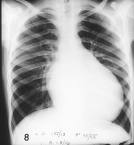Diagnosis of Angina Pectoris
 The most important diagnostic evidence of angina pectoris is the patient’s history. If the chest pain is central in location, brief in duration, oppressive in quality and related to effort, the diagnosis of angina pectoris is virtually assured; no other confirmation is necessary. Physical examination and electrocardiograms at rest are normal in the majority of patients and seldom contribute directly to the diagnosis. When the chest pain pattern is suspicious but not entirely characteristic of angina, several diagnostic tests may be performed to determine if the pain is ischemic in origin.
The most important diagnostic evidence of angina pectoris is the patient’s history. If the chest pain is central in location, brief in duration, oppressive in quality and related to effort, the diagnosis of angina pectoris is virtually assured; no other confirmation is necessary. Physical examination and electrocardiograms at rest are normal in the majority of patients and seldom contribute directly to the diagnosis. When the chest pain pattern is suspicious but not entirely characteristic of angina, several diagnostic tests may be performed to determine if the pain is ischemic in origin.
Exercise (Stress) Testing. The simplest and most widely used diagnostic method is the exercise, or stress, test. It consists of recording an electrocardiogram during progressively strenuous exercise when the oxygen demands of the myocardium increase greatly and electrocardiographic signs of myocardial ischemia are most likely to appear. The exercise is performed by riding a stationary bicycle or walking on a treadmill while the heart rate, blood pressure and electrocardiogram are monitored continuously. The test starts with low level exercise and builds up in stages until a target heart rate (based on the patient’s age) is achieved. In patients with significant obstructive disease of the coronary arteries a point is soon reached where myocardial oxygen demand exceeds oxygen supply and, as a consequence, electrocardiographic signs of myocardial ischemia appear. Although chest pain may develop during exercise, a positive stress test is defined only on the basis of characteristic electrocardiographic changes of ischemia, not the presence or absence of angina. One of the main limitations of stress testing is that many elderly or sedentary patients are unable to exercise sufficiently to achieve the target heart rate; the test must often be terminated prematurely in this group because of fatigue, leg weakness or shortness of breath.
Radionuclide Studies. In recent years various nuclear scanning techniques have assumed an increasingly useful role in the diagnosis and assessment of CHD. One of these methods, known as radionuclide angiography, provides indirect information about myocardial blood flow and is used in combination with exercise testing to confirm the diagnosis of angina pectoris. The test is based on the fact that myocardial ischemia, in addition to producing typical electrocardiographic signs, also causes abnormalities in contraction of segments (regions) of the left vcntricle. These transient abnormalities in regional ventricular wall motion with exercise can be detected by nuclear scanning of the heart. The procedure involves the intravenous injection of a radioactive isotope at the peak exercise period and then sequentially recording ventricular wall motion with a nuclear camera. With significant coronary artery disease blood flow to the region supplied by the involved vessel is reduced, as reflected by the abnormal contractile pattern of that portion of the ventricle. Radionuclide angiography has greater diagnostic accuracy than customary stress testing alone, but it is much more costly.
Coronary Arteriography. The most definitive method for the diagnosis of coronary obstructive disease is coronari, arteriography. In fact it serves as the standard of accuracy for the comparison of all other tests used in the diagnosis of CHD. As mentioned previously, coronary arteriography permits visualization of the coronary arteries (with a radiopaque dye) and thereby defines the precise number of arteries involved, the extent of narrowing in each vessel, and the degree of collateral circulation. This anatomic description of the disease process is particularly important in evaluating patients for coronary bypass surgery.
In addition to coronary arteriography, cardiac catherization and ventriculography are also performed as part of a complete study. Cardiac catheterization involves the introduction of catheters into the cardiac chambers and great vessels in order to measure pressures and oxygen concentrations in each of these sites. These data are essential for patients in whom coronary surgery is contemplated. Ventriculography is used to assess ventricular pumping function and to detect regional wall abnormalities. The technique consists of injecting a radiopaque dye through a catheter placed in the left ventricle and recording motion pictures of ventricular motion. This latter information is similar, but more precise, than that obtained by radionuclide studies. The main disadvantage of coronary arteriography (and the other components of the test) is that heart catheterization is an invasive procedure not entirely without risk, and requires expensive hospitalization.
NEXT : Stable and Variant Angina Pectoris







![Iceberg (visible and invisible part) [explored 25/04/2024] Iceberg (visible and invisible part) [explored 25/04/2024]](https://live.staticflickr.com/65535/53567620448_3a3058b0a9_s.jpg)


